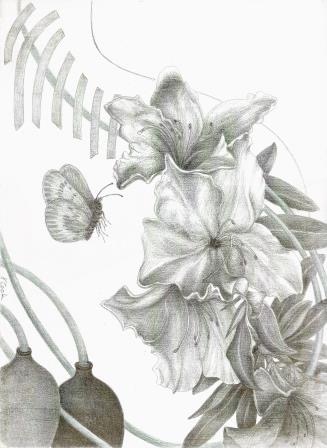Untitled, Patrick Fagerberg
I recently had an exchange of e-mails with a fellow artist friend, whose wife had suddenly become very ill. Both of us commented on the fact that there is such a change of optic when one is struck by serious family illness or some other type of trauma. Everything important comes back into sharp focus and the “small stuff” falls away.
The conversation suddenly reminded me of various silverpoint drawings that I have been impelled to do after different frights about my and my husband’s health. It is almost as if, subconsciously, art allows me to try to right my world again when it has got turned upside down. Once completed, I have always put these drawings away and gone on with life, rather conscious that they would probably be incomprehensible to others and also, most likely, of little interest. Nonetheless, I know that different artists have produced some powerful art as they endeavour to cope with their lives.
Recovering from Surgery, silverpoint, Jeannine Cook artist
Line to the Alveoli, goldpoint-silverpoint, Jeannine Cook artist
Remember, it was Paul Klee who said, “I create – in order not to cry.”
One of the most celebrated artists to use his personal reactions to the stresses of modern existence was Edvard Munch. Everyone knows his iconic painting of “The Scream”, but Munch spent most of the time between 1893 and 1902 working on a series of canvases for the “Frieze of Life”. In these paintings, he explored many psychological aspects of contemporary life, such as illness, death, loneliness, despair and other emotional suffering.
Anxiety, 1894, Edvard Munch, oil on canvas, (Image courtesy of Munch Museum, Oslo, Norway)
As the twentieth century grew darker and World War I left so many psychologically suffering people, it was again artists who sought to purge their appalling angst in art, literature, theatre. Otto Dix, an ardent German patriot as he went into the War, later produced some of the most searing art imaginable denouncing its horrors and hellish apocalypse as he tried to deal with what would now be termed post-traumatic stress disorder.
Shell Holes near Dontrien, Illuminated by Flares 1924 © Estate of Otto Dix ( Photograph: Courtesy The Trustees of the British Museum)
The German expressionist painter, Ernst Ludwig Kirchner, also joined up to fight in 1914, but he suffered a nervous breakdown and was soon invalided out of the Army. Trauma and alcoholism resulted, but again, he produced some poignant, powerful art as he worked his way though this anguish.
Ernst Ludwig Kirchner, Self-portrait as a Sick Person, 1918, (Image courtesy of Pinakothek der Moderne, Munich)
World War II produced some haunting art that perhaps merits being studied thoughtfully again as today’s world keeps staggering into murderous upheavals and extremes of societal and political conflict. As the War lurched to an end in Europe and the indescribable camps – Auschwitz-Birkenau, Buchenwald and Terezín (Theresienstadt), Bergen-Belsen and others – were liberated, both official war artists and survivors sought to bear witness and to try to come to terms with such evil. Jan Hartman (1926-2009), for instance, born in Czechoslovakia, was deported with his brother to Terezín in 1942, and later moved to Auschwitz-Birkenau, Czestochowa and Buchenwal. Eventually liberated in 1945, Hartman was reunited with his brother but learned his parents had been killed at Auschwitz. Shortly following his return home, Jan began a series of paintings which reflected his experience in the camp system.
Death March, Czechowice-Bielsko, January 1945, Jan Hartman (Courtesy of the Jan Hartman estate)
Shmuel Dresner, born in Warsaw in 1928, was only 12 when he was forced into the ghetto, along with Warsaw’s other Jewish residents. After escaping, he was caught and held as a slave labourer in different camps, including Buchenwald and Terezín. Arriving in England in 1945, Dresner spent time in sanatoriums, and there he started to paint. Benjamin (1982) is a portrait and tribute to Dresner’s close friend, Benjamin, whom he met in a camp,and who helped sustain him with his optimism and cheerfulness. After two years together, Benjamin was eventually killed. Post-War, Dresner used his art to try to come to terms with his experiences, and this portrait was done in memory of his lost friend, Benjamin.
Benjamin, 1982, Shmuel Dresner (Image courtesy of the artist)
Just recently, successful defence lawyer, Patrick Fagerberg, was attending a concert in his home town of Austin, Texas, when a 400-lb camera boom collapsed and fell on him, striking his head and injuring the left hemisphere of his brain. During his recovery, no longer able to practice law, he turned to art therapy as a way to cope. He discovered that he had a serious talent for painting. One of his paintings, “untitled”, opens this blog entry.
I think that artists (and those who become artists as the result of some traumatic experience) are incredibly lucky that they have a way to face and deal with the twists and turns of life that can be so devastating. The widespread use of art therapy in all sorts of health-related institutions is an eloquent reminder of what all of us seem intuitively to realise – art heals. Art helps us think, remember, rejoice, celebrate and bear witness.







